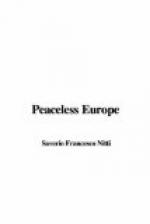Creation of the Free State of Danzig within the limits of Art. 100, under the protection of the League of Nations. The city is a Free City, but enclosed within the Polish Customs House frontiers, and Poland has full control of the river and of the railway system. Poland, moreover, has charge of the foreign affairs of the Free City of Danzig and undertakes to protect its subjects abroad.
Surrender to the victors, or, to be more precise, almost exclusively to Great Britain and France, of all the German colonies (Art. 119 and 127). The formula (Art. 119) is that Germany renounces in favour of the leading allied and associated Powers all her territories beyond the seas. Great Britain has secured an important share, but so has France, receiving that part of Congo ceded in 1911, four-fifths of the Cameroons and of Togoland.
Abandonment of all rights and claims in China, Siam, Liberia, Morocco, Egypt, Turkey, Bulgaria and Shantung (Art. 128 and 158).
Creation of a League of Nations to the exclusion, practically, of Germany and of the other losing countries, with the result that the League is nothing but a juridical completion of the Commission of Reparations. In all of the various treaties, the pact of the League of Nations, the Covenant, left standing among the collapse of President Wilson’s other ideas and proposals, is given precedence over all other clauses.
II.—MILITARY CLAUSES AND GUARANTEES
Germany is obliged, and with her, by the subsequent treaties, all the other losing countries, to surrender her arms and to reduce her troops to the minimum necessary for internal defence (Art. 159 and 213). The German army has no General Staff; its soldiers are mercenaries who enlist for a period of ten years; it cannot be composed of more than seven infantry and three cavalry divisions, not exceeding 100,000 men including officers: no staff, no military aviation, no heavy artillery. The number of gendarmes and of local police can only be increased proportionately with the increase of the population. The maximum of artillery allowed is limited to the requirements of internal defence. Germany is strictly forbidden to import arms, ammunition and war material of any kind or description. Conscription is abolished, and officers must remain with the colours at least till they have attained the age of forty-five. No institute of science or culture is allowed to take an interest in military questions. All fortifications included in a line traced fifty kilometres to the east of the Rhine are to be destroyed, and on no account may German troops cross the said line.
Destruction of Heligoland and of the fortresses of the Kiel Canal.
Destruction under the supervision of the allied commissions of control of all tanks, flying apparatus, heavy and field artillery, namely 35,000 guns, 160,000 machine guns, 2,700,000 rifles, besides the tools and machinery necessary for their manufacture. Destruction of all arsenals. Destruction of the German fleet, which must be limited to the proportions mentioned in Art. 181.




